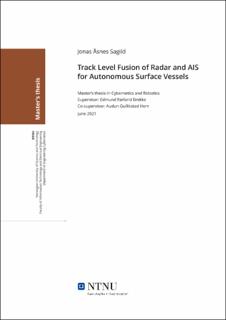| dc.contributor.advisor | Brekke, Edmund Førland | |
| dc.contributor.advisor | Hem, Audun Gullikstad | |
| dc.contributor.author | Sagild, Jonas Åsnes | |
| dc.date.accessioned | 2021-09-23T19:05:00Z | |
| dc.date.available | 2021-09-23T19:05:00Z | |
| dc.date.issued | 2021 | |
| dc.identifier | no.ntnu:inspera:76427839:27184120 | |
| dc.identifier.uri | https://hdl.handle.net/11250/2781105 | |
| dc.description.abstract | Denne oppgaven omhandler "track level"-metoden (spornivåtilnærmingen) for sammenslåing av "Automatic Identification System (AIS)"-meldinger og radarmålinger. En fullstendig tilnærming på spornivå til AIS-radarfusjon har blitt utviklet, bestående av løsninger på spor-til-spor-tilknytning og spor-til-spor-sammenslåingsproblemer.
Spor-til-spor-tilknytning løses vanligvis ved en hypotesetest som krever kovariansinformasjon fra estimatene. Dessverre er kovariansinformasjon ikke alltid tilgjengelig fra de enkelte sporingssystemene. En alternativ tilnærming som kan brukes i slike tilfeller er en telleteknikk hvor antall gode treff brukes som en teststatistikk. Denne oppgaven sammenligner telleteknikken med en konvensjonell hypotesetest ved simuleringer av et fullstendig fler-måls sporingssytem system. Da datatilknytningen til radarsporingssystemet gjør det vanskelig å bestemme seg for en "ground truth", foreslås også en ny måte å evaluere "ground truth" ved hjelp av en glidende vindu-tilnærming. Resultatene indikerer at telleteknikken presterer like godt som hypotesetesten under visse sporingsforhold.
Videre sammenlignes AIS-radar spornivåtilnærmingen med en målesnivåstilnærming. Resultatene antyder at spornivåtilnærmingen er litt mindre konsistent, men fungerer bedre når det gjelder posisjonsfeil. | |
| dc.description.abstract | This thesis concerns the track level approach to the fusion of Automatic Identification System (AIS) messages and radar measurements. A complete track level approach to AIS-radar fusion is developed, consisting of solutions to the track-to-track association and the track-to-track fusion problems.
Track-to-track association is typically solved by a hypothesis test, which requires information from the covariances of the estimates. Unfortunately, covariance information is not always available from the individual tracking systems. An alternative approach that can be used in such cases is a counting technique, where the number of good matches is used as a test statistic. This thesis compares the counting technique with a conventional hypothesis test by simulations using a complete multi-target tracking system. Furthermore, since the data association of the radar tracking system inevitably makes it nontrivial to decide on a ground truth, we also propose a ground truth assessment scheme using a sliding window approach. The results indicate that the counting technique performs at par with the hypothesis test under certain tracking conditions.
Further, the complete AIS-radar track level multi-target tracking system is compared to a measurement level tracking system. The results suggest that the track level approach is a bit less consistent but perform better in terms of positional error. | |
| dc.language | eng | |
| dc.publisher | NTNU | |
| dc.title | Track Level Fusion of Radar and AIS for Autonomous Surface Vessels | |
| dc.type | Master thesis | |
